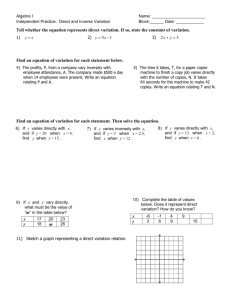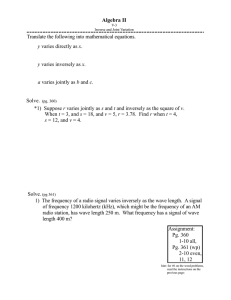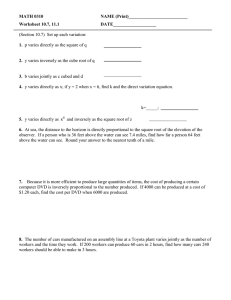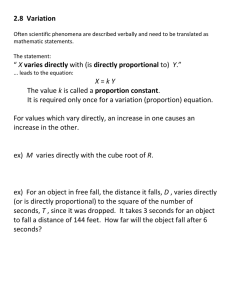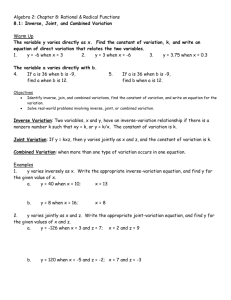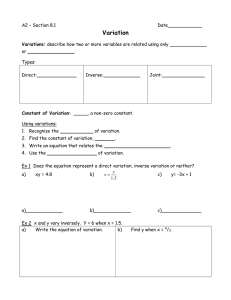File
advertisement
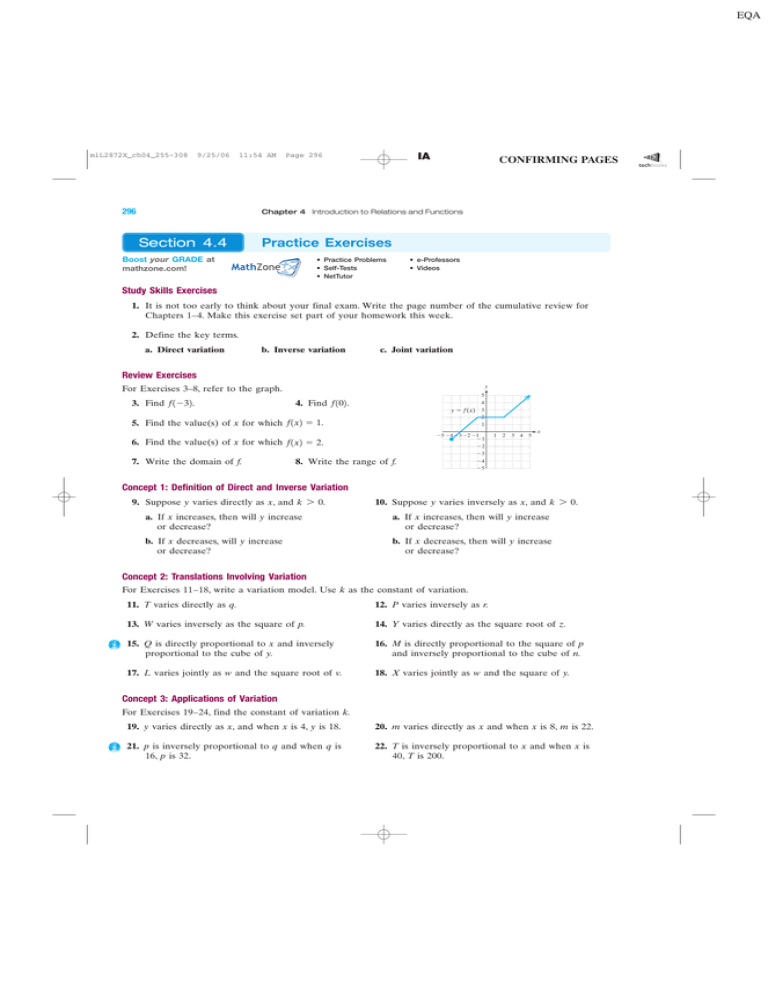
miL2872X_ch04_255-308 9/25/06 11:54 AM 296 IA Page 296 CONFIRMING PAGES Chapter 4 Introduction to Relations and Functions Section 4.4 Practice Exercises Boost your GRADE at mathzone.com! • Practice Problems • Self-Tests • NetTutor • e-Professors • Videos Study Skills Exercises 1. It is not too early to think about your final exam. Write the page number of the cumulative review for Chapters 1–4. Make this exercise set part of your homework this week. 2. Define the key terms. a. Direct variation b. Inverse variation c. Joint variation Review Exercises For Exercises 3–8, refer to the graph. 3. Find f 132. y 4. Find f 102. 5 4 y f (x) 3 5. Find the value(s) of x for which f 1x2 1. 2 1 6. Find the value(s) of x for which f 1x2 2. 7. Write the domain of f. 5 4 3 2 1 1 2 8. Write the range of f. 1 2 3 4 5 x 3 4 5 Concept 1: Definition of Direct and Inverse Variation 9. Suppose y varies directly as x, and k 7 0. 10. Suppose y varies inversely as x, and k 7 0. a. If x increases, then will y increase or decrease? a. If x increases, then will y increase or decrease? b. If x decreases, will y increase or decrease? b. If x decreases, then will y increase or decrease? Concept 2: Translations Involving Variation For Exercises 11–18, write a variation model. Use k as the constant of variation. 11. T varies directly as q. 12. P varies inversely as r. 13. W varies inversely as the square of p. 14. Y varies directly as the square root of z. 15. Q is directly proportional to x and inversely proportional to the cube of y. 16. M is directly proportional to the square of p and inversely proportional to the cube of n. 17. L varies jointly as w and the square root of v. 18. X varies jointly as w and the square of y. Concept 3: Applications of Variation For Exercises 19–24, find the constant of variation k. 19. y varies directly as x, and when x is 4, y is 18. 20. m varies directly as x and when x is 8, m is 22. 21. p is inversely proportional to q and when q is 16, p is 32. 22. T is inversely proportional to x and when x is 40, T is 200. miL2872X_ch04_255-308 9/25/06 11:54 AM Page 297 IA CONFIRMING PAGES Section 4.4 Variation 23. y varies jointly as w and v. When w is 50 and v is 0.1, y is 8.75. 297 24. N varies jointly as t and p. When t is 1 and p is 7.5, N is 330. Solve Exercises 25–30 by using the steps found on page 292. 25. Z varies directly as the square of w, and Z 14 when w 4. Find Z when w 8. 26. Q varies inversely as the square of p, and Q 4 when p 3. Find Q when p 2. 27. L varies jointly as a and the square root of b, and L 72 when a 8 and b 9. Find L when a 12 and b 36. 28. Y varies jointly as the cube of x and the square root of w, and Y 128 when x 2 and w 16. Find Y when x 12 and w 64. 29. B varies directly as m and inversely as n, and B 20 when m 10 and n 3. Find B when m 15 and n 12. 30. R varies directly as s and inversely as t, and R 14 when s 2 and t 9. Find R when s 4 and t 3. For Exercises 31–42, use a variation model to solve for the unknown value. 31. The amount of pollution entering the atmosphere varies directly as the number of people living in an area. If 80,000 people cause 56,800 tons of pollutants, how many tons enter the atmosphere in a city with a population of 500,000? 32. The area of a picture projected on a wall varies directly as the square of the distance from the projector to the wall. If a 10-ft distance produces a 16-ft2 picture, what is the area of a picture produced when the projection unit is moved to a distance 20 ft from the wall? 33. The stopping distance of a car is directly proportional to the square of the speed of the car. If a car traveling at 40 mph has a stopping distance of 109 ft, find the stopping distance of a car that is traveling at 25 mph. (Round your answer to 1 decimal place.) 34. The intensity of a light source varies inversely as the square of the distance from the source. If the intensity is 48 lumens (lm) at a distance of 5 ft, what is the intensity when the distance is 8 ft? 35. The current in a wire varies directly as the voltage and inversely as the resistance. If the current is 9 amperes (A) when the voltage is 90 volts (V) and the resistance is 10 ohms (), find the current when the voltage is 185 V and the resistance is 10 . 36. The power in an electric circuit varies jointly as the current and the square of the resistance. If the power is 144 watts (W) when the current is 4 A and the resistance is 6 , find the power when the current is 3 A and the resistance is 10 . 37. The resistance of a wire varies directly as its length and inversely as the square of its diameter. A 40-ft wire with 0.1-in. diameter has a resistance of 4 . What is the resistance of a 50-ft wire with a diameter of 0.20 in.? 38. The frequency of a vibrating string is inversely proportional to its length. A 24-in. piano string vibrates at 252 cycles/sec. What is the frequency of an 18-in. piano string? 39. The weight of a medicine ball varies directly as the cube of its radius. A ball with a radius of 3 in. weighs 4.32 lb. How much would a medicine ball weigh if its radius were 5 in.?
